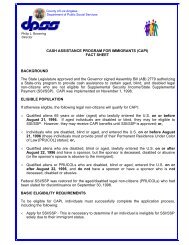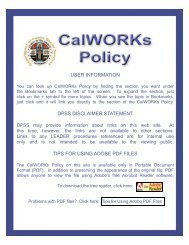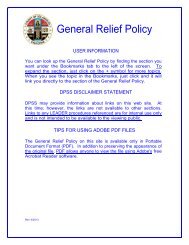leader replacement system - Department of Public Social Services ...
leader replacement system - Department of Public Social Services ...
leader replacement system - Department of Public Social Services ...
Create successful ePaper yourself
Turn your PDF publications into a flip-book with our unique Google optimized e-Paper software.
Los Angeles County<br />
<strong>Department</strong> <strong>of</strong> <strong>Public</strong> <strong>Social</strong> <strong>Services</strong><br />
LEADER Replacement System (LRS)<br />
91<br />
92<br />
93<br />
94<br />
95<br />
96<br />
97<br />
98<br />
99<br />
100<br />
101<br />
102<br />
103<br />
104<br />
105<br />
106<br />
107<br />
108<br />
109<br />
110<br />
111<br />
112<br />
113<br />
114<br />
115<br />
116<br />
117<br />
118<br />
119<br />
120<br />
121<br />
122<br />
123<br />
124<br />
125<br />
126<br />
127<br />
128<br />
129<br />
130<br />
131<br />
132<br />
133<br />
134<br />
135<br />
• Industry-Proven Technology. All new <strong>system</strong> acquisition and infrastructure<br />
should use commercially viable, industry-proven, widely-used technology to<br />
the maximum extent possible. Use <strong>of</strong> industry-proven, widely-used<br />
technology allows for easier access to affordable skills and a large base <strong>of</strong><br />
proven s<strong>of</strong>tware solutions. It can reduce risk, and helps ensure robust product<br />
support. Wherever practical, the County should implement commercial-<strong>of</strong>fthe-shelf<br />
technology as a first preference over completely custom<br />
applications. Open Source s<strong>of</strong>tware should only be used when a viable set <strong>of</strong><br />
commercial vendors have committed to support it.<br />
• Countywide Network Backbone. The Los Angeles County Enterprise<br />
Network (LAnet-EN) will be used as countywide network backbone for<br />
applications and services to foster greater collaboration and sharing <strong>of</strong> data<br />
between County departments and agencies. The County uses the TCP/IP<br />
family <strong>of</strong> protocols as the standard network protocol to ensure technical<br />
compatibility and efficient use <strong>of</strong> the available data transport resources.<br />
• Multi-tier Server Architecture. All new <strong>system</strong> acquisition and development<br />
should employ a multi-tiered architecture that separates presentation,<br />
business logic, database and other services into logical components. A multitiered<br />
architecture provides architectural flexibility from many perspectives<br />
including scalability to meet future growth needs, selection <strong>of</strong> different<br />
platforms to meet potential changes to technology standards and directions,<br />
and minimization <strong>of</strong> technology obsolescence.<br />
• Web Browser Client. All new <strong>system</strong> acquisition and development should<br />
employ server-based thin client solutions requiring only network access and a<br />
Web browser for end-user access whenever such solutions are technically<br />
appropriate. Through the use <strong>of</strong> server-based applications, thin client<br />
technologies (especially Web-based clients), portals, and gateways, County<br />
<strong>Department</strong>s can reduce the cost and complexity <strong>of</strong> all IT functions, making it<br />
easier to implement, deploy, manage, and monitor applications and<br />
information resources. Server-based architecture provides the ability to rollout<br />
new applications and upgrades to the entire organization simultaneously.<br />
• Server Consolidation. To the extent possible, <strong>system</strong>s should utilize new<br />
technologies and architectures that provide for a consolidated server<br />
environment. Such consolidated server environment will streamline s<strong>of</strong>tware<br />
licensing, more efficient <strong>system</strong> administration, better scalability and<br />
utilization planning, and provide a more effective management <strong>of</strong> storage,<br />
<strong>system</strong> capacity and performance, and backup and disaster recovery.<br />
• Service Oriented Architecture (SOA). This approach requires that County<br />
and its <strong>Department</strong>s take a critical look at their operations and develop a<br />
“service-based” business model. Such modularization at the business level<br />
LRS RFP - Attachment H (Technical Exhibits) Page 10 November 30, 2007
















